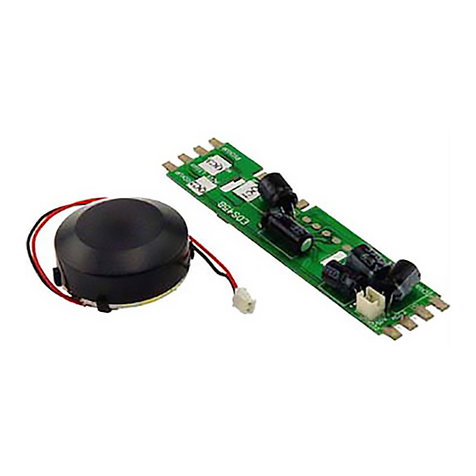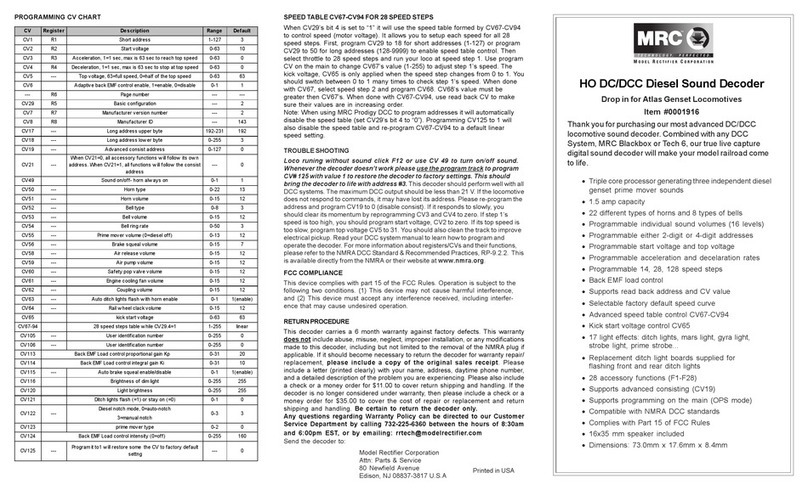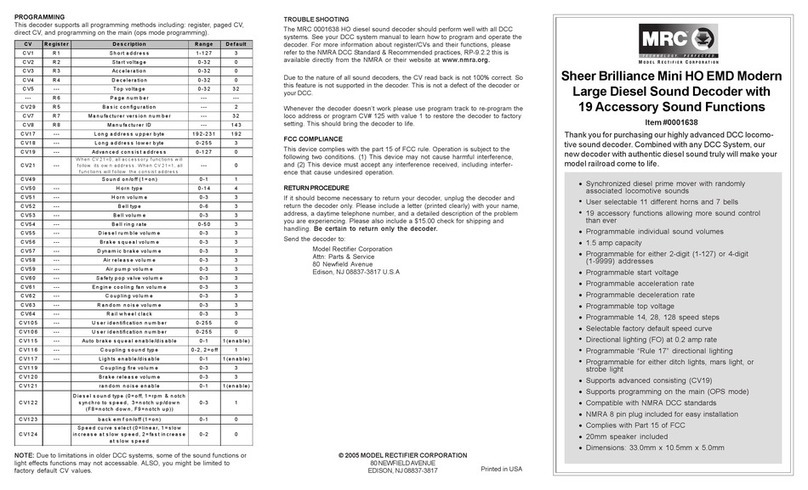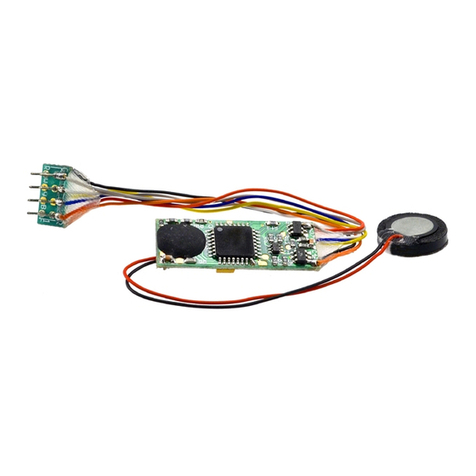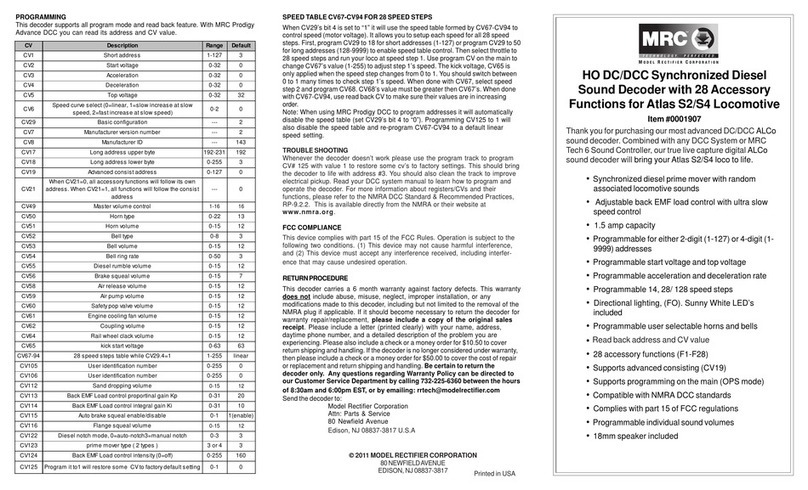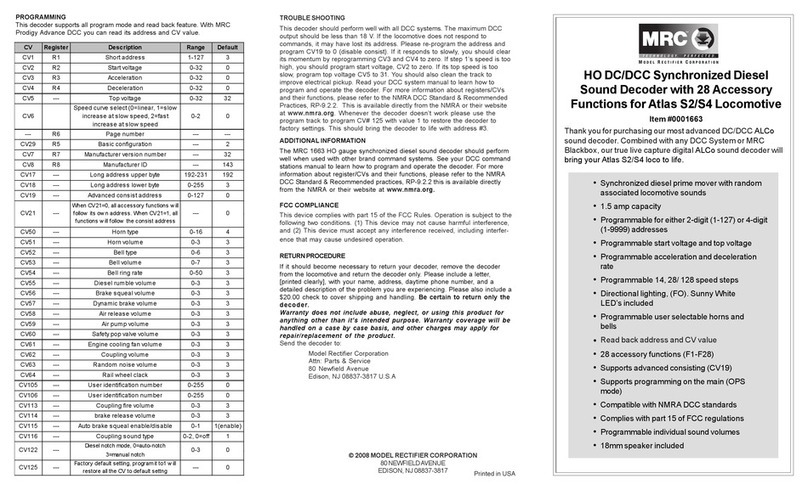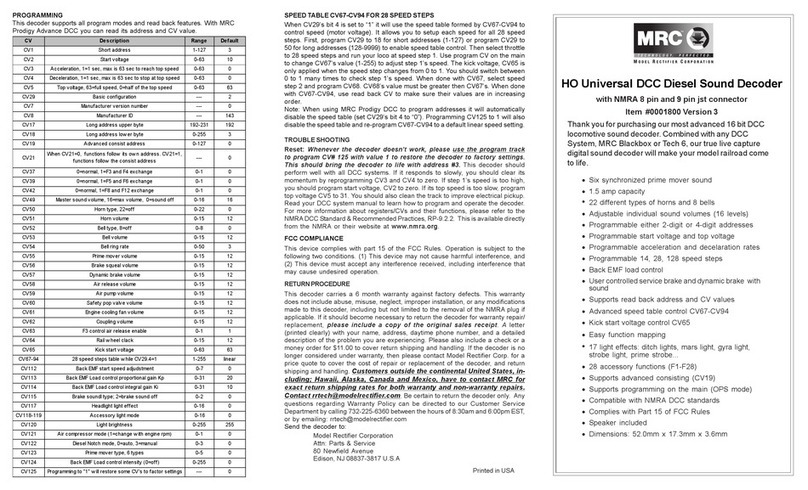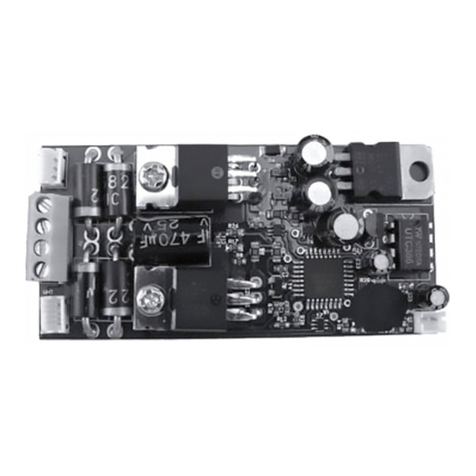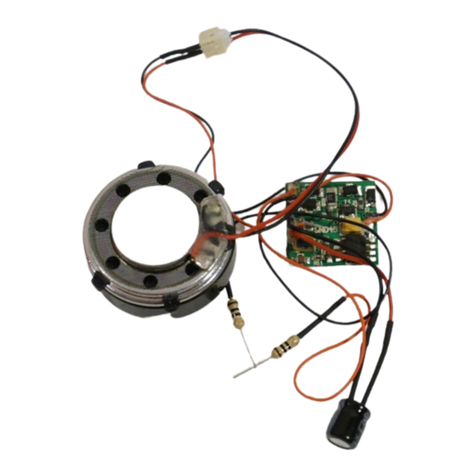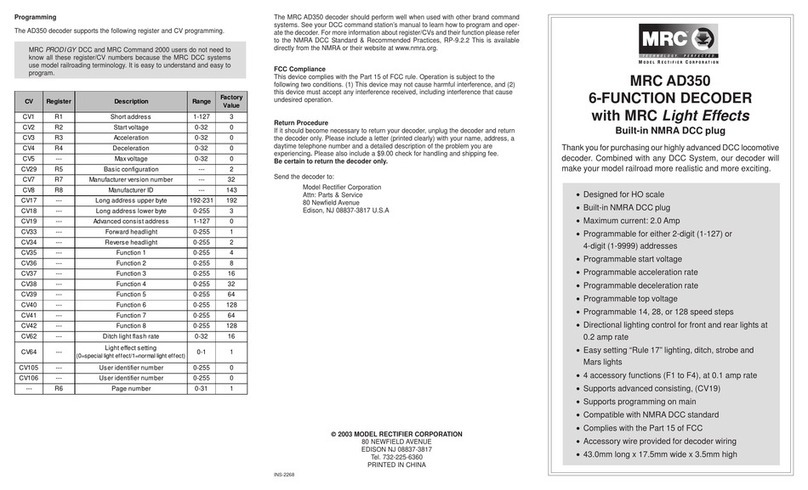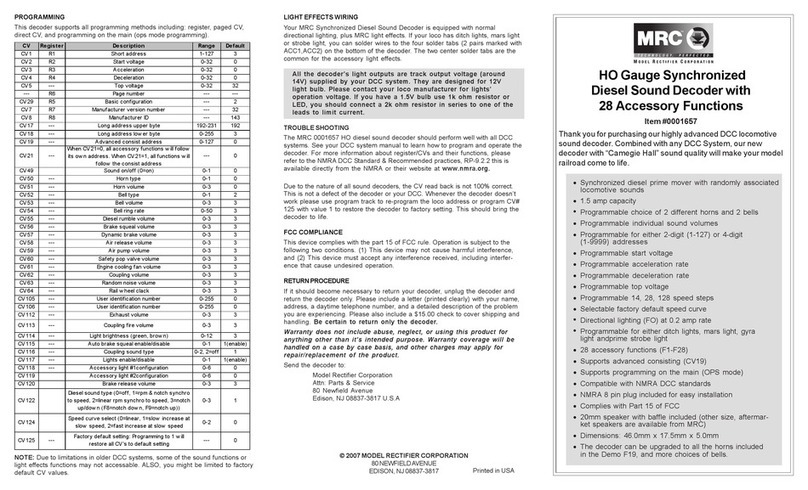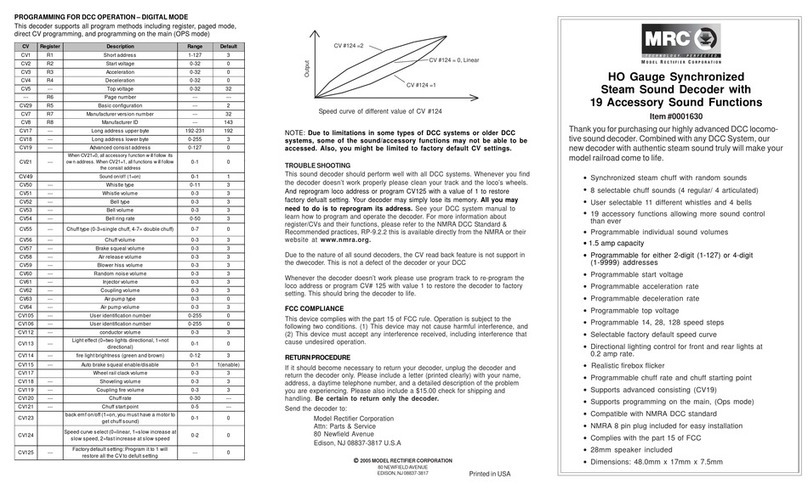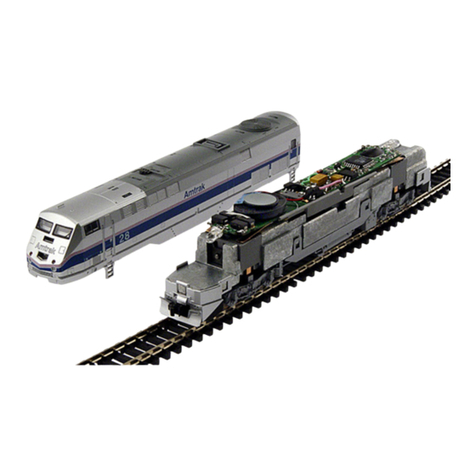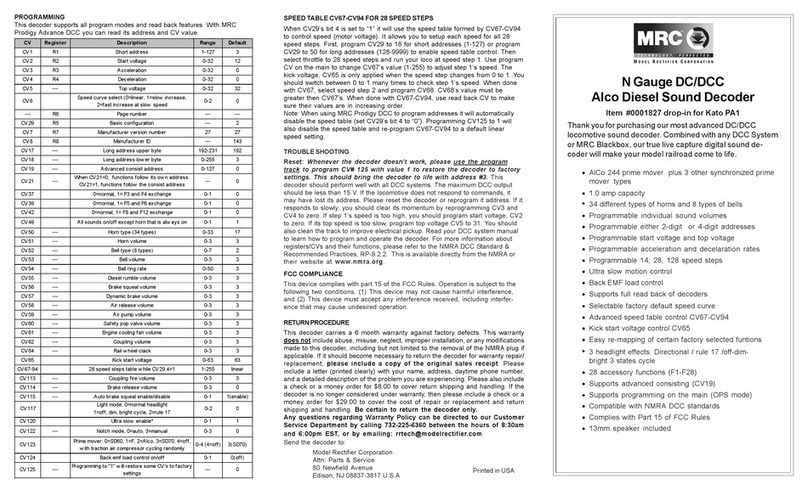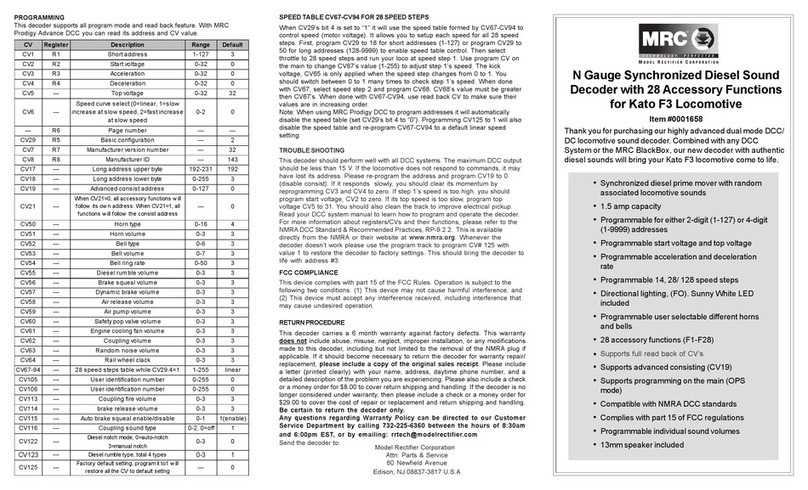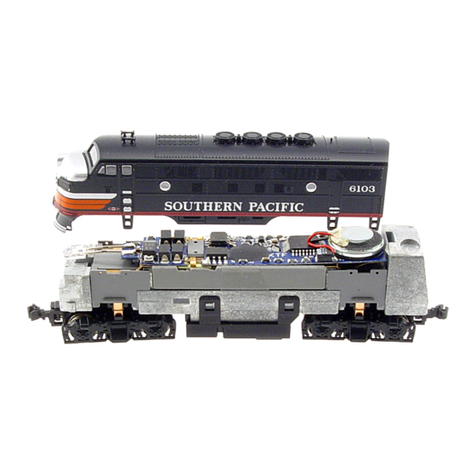
Programming
The 0001651 decoder supports the following register and CV program-
ming.
MRC 1651
4-FUNCTION DECODER
with MRC Light Effects
Built-in NMRA DCC & 9-pin plug
Thank you for purchasing our highly advanced DCC locomotive
decoder. Combined with any DCC System, our decoder will
make your model railroad more realistic and more exciting.
•Designed for HO scale
•Built-in NMRA DCC plug and 9-pin plug
•Maximum current: 1.5 Amp
•Programmable for either 2-digit (1-127) or
4-digit (1-9999) addresses
•Programmable start voltage
•Programmable acceleration rate
•Programmable deceleration rate
•Programmable speed curve (factory pre-set)
•Programmable top voltage
•Programmable 14, 28, or 128 speed steps
•Directional lighting at 0.1 amp rate
•Easy setting “Rule 17” lighting, ditch, strobe and
Mars lights
•2 accessory functions (ACC1 & ACC2), at 0.1 amp
rate
•Supports advanced consisting, (CV19)
•Supports programming on main
•Compatible with NMRA DCC standard
•Complies with the Part 15 of FCC
•26.5mm long x 15.0mm wide x 5.0mm high
The MRC 0001651 decoder should perform well with your DCC system.
See your DCC command station’s manual to learn how to program and
operate the decoder.
FCC COMPLIANCE
This device complies with the Part 15 of FCC rule. Operation is subject to
the following two conditions. (1) This device may not cause harmful
interference, and (2) this device must accept any interference received,
including interference that cause undesired operation.
TROUBLE SHOOTING
Whenever you find the decoder doesn’t work properly please clean your
track and the loco’s wheels. And reprogram loco address or program
CV125 with a value of 1 to restore factory defualt setting. Your decoder
may simply lose its memory. All you may need to do is to reprogram its
address.
RETURN PROCEDURE
If it should become necessary to return your decoder, unplug the decoder
and return the decoder only. Please include a letter (printed clearly) with
your name, address, a daytime telephone number and a detailed
description of the problem you are experiencing. Please also include a
$9.00 check for shipping and handling fee.
Be certain to return the decoder only.
Send the decoder to:
Model Rectifier Corporation
Attn: Parts & Service
80 Newfield Avenue
Edison, NJ 08837-3817 U.S.A
2007 MODEL RECTIFIER CORPORATION
80 NEWFIELDAVENUE
EDISON NJ 08837-3817
Tel. 732-225-6360
PRINTED IN USA
ABOUT BACK EMF SPEED CONTROL
The decoder has back emf speed control abliity. By programming CV123
with a value of 1 will enable back emf. However back emf may not be
suitable for the type of motor in the locomotive. If your locomotive hesitates
in the mid to high speed range turn the back emf feature off by programming
CV123 with a value of 0.
HOW TO SELECT SPEED CONTROL
You can select three speed curves (linear, slow increasing, fast increasing).
The figure below shows the CV124’s value and its speed curve.
You can also enable back emf by program CV 123 with value of 1. When
you enable back emf, it will automaticall add momentum for a smooth
speed control.
Output
CV #124 =1
CV #124 =2
CV #124 = 0, Linear
Speed curve of different value of CV #124
CV Register Description Range Default
CV1 R1 Short address 1-127 3
CV2 R2 Start voltage 0-32 0
CV3 R3 Acceleration 0-32 0
CV4 R4 Deceleration 0-32 0
CV5 --- Top voltage 0-32 32
--- R6 Page number --- ---
CV29 R5 Basic configuration --- 2
CV7 R7 Manufacturer version number --- 32
CV8 R8 Manufacturer ID --- 143
CV17 --- Long address upper byte 192-231 192
CV18 --- Long address lower byte 0-255 3
CV19 --- Advanced consist address 0-127 0
CV60 head light CV60=0 for directional, =1 for rule 17,
=2 for on/off at same time 0-2 0
CV105 --- User identification number 0-255 0
CV106 --- User identification number 0-255 0
CV112 ACC1 light type control (green wire) 0-5 0
CV113 ACC1 light type control (pink wire) 0-5 0
CV124
Speed curve select (0=linear, 1=slow
increase at slow speed, 2=fast
increase at slow speed
0-2 0
CV125 --- Factorydefault setting: Program it to 1
will restore all the CV to defult setting --- 0
CV21 --- 0
When CV21=0, all accessory function w ill
follow its ow n address. When CV21=1, all
functions w ill f ollow the consist address
0-1












